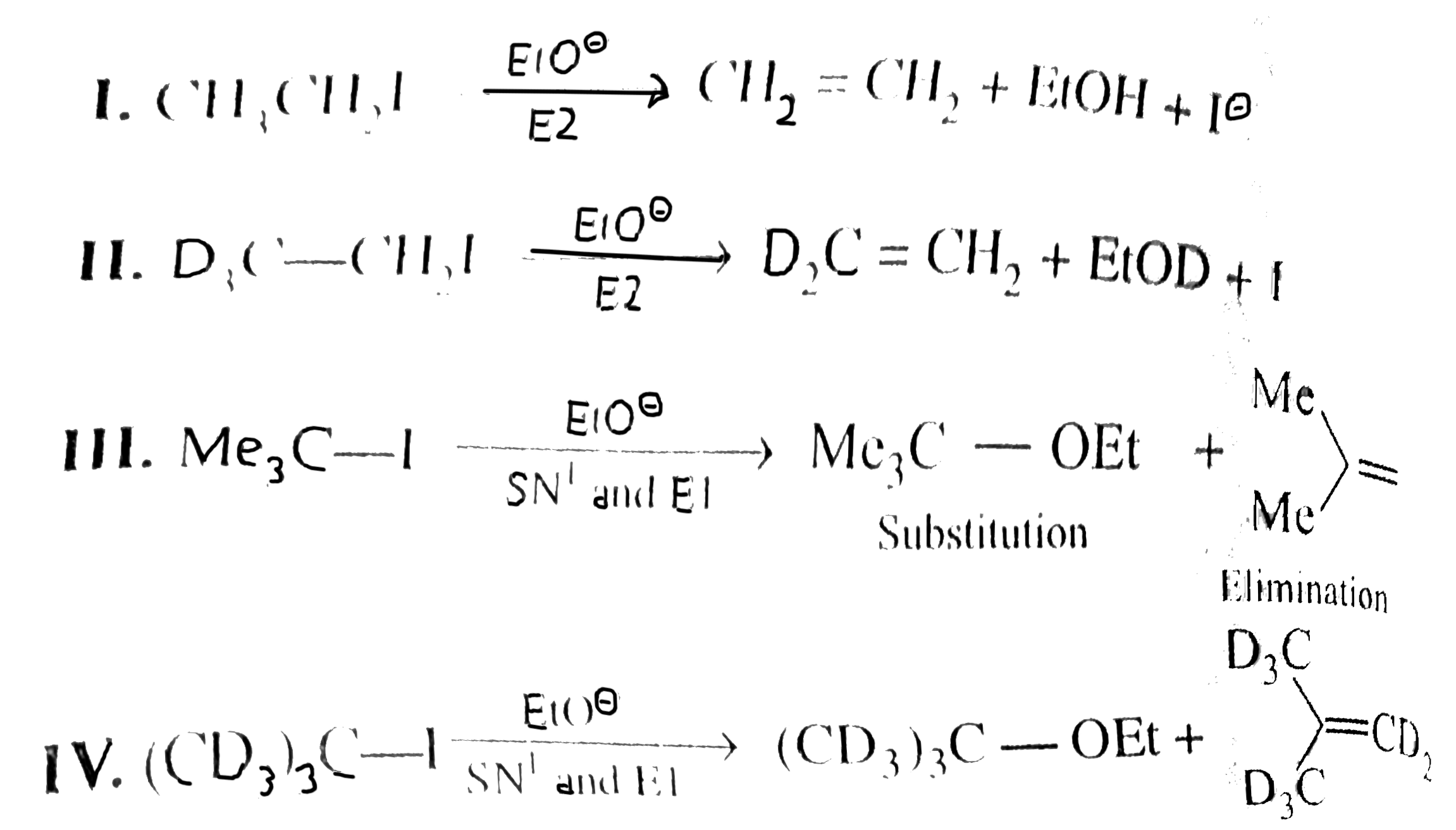Consider the following reactions:
I. CH3CH2IEtOo−−−−−−−→E2CH2=CH2+EtOH+Io−
II. D3C−CH2IEtOo−−−−−−−→E2D2C=CH2+EtOD+Io−

Which of the following statement9s) is/are correct?
Reactions (I) and (II) show primary kinetic istope effect, whereas reactions (III) and (IV) show 2∘ kinetic isotope effect.
Reactions (I) and (II) show 2∘ kinetic isotope effect, whereas reactions (III) and (IV) show 1∘kinetic isotope effect.
All reactions show 1∘ kinetic isotope effect.
All reactions show 2∘ kinetic isotpe effect.
The correct Answer is:a
i. (I) and (II) are E2 reactions in whch the R.D.S is breasking of (C−H) or (C−D) bond. Thus E2 elimination of (I) and (II) show 1∘ kinetic isotope effect.
ii. (III) and (IV) are either E1 or SN1 reactions, which involve the formation of same inermediate Me3C⊕ or (CD3)3C⊕ in the R.D.S This step does not involve any (C−H) or (C−D) bond breaking , so H/D effect is not 1∘ but rather a small 2∘ isotope effect, where KH/KD=0.7/1.5.
Reaction (III) is faster than (IV) since (CD3)3C⊕ is not as stable as Me3C⊕ becuase CD3 is not as good an ovel∈e(e)'s donator as CH3 Moreover, (C−D) is not a good hyperconjugative participant as (C−H)
Topper's Solved these Questions
- AROMATIC COMPOUNDS AND ALKYL AND ARYL HALIDES BOOK - CENGAGE CHEMISTRYCHAPTER - AROMATIC COMPOUNDS AND ALKYL AND ARYL HALIDES EXERCISE - Exercises Single Correct
161 Videos
- AROMATIC COMPOUNDS AND ALKYL AND ARYL HALIDES BOOK - CENGAGE CHEMISTRYCHAPTER - AROMATIC COMPOUNDS AND ALKYL AND ARYL HALIDES EXERCISE - Exercises Single Correct Answer Type
26 Videos
- AROMATIC COMPOUNDS AND ALKYL AND ARYL HALIDES BOOK - CENGAGE CHEMISTRYCHAPTER - AROMATIC COMPOUNDS AND ALKYL AND ARYL HALIDES EXERCISE - Exercises Multiple Correct
35 Videos
- APPENDIX INORGANIC VOLUME 2BOOK - CENGAGE CHEMISTRYCHAPTER - APPENDIX INORGANIC VOLUME 2EXERCISE - Short Answer Type
179 Videos
- BIOMOLECULESBOOK - CENGAGE CHEMISTRYCHAPTER - BIOMOLECULESEXERCISE - Exercises Archives (Analytical And Descriptive)
8 Videos
Similar Questions
In the following reaction C is, CH3−CH=CH2+ HCl
Organic−−−−−−→PeroxideAAg2O−−−−−→MoistBEt MgBr−−−−→C
View SolutionDirection (Q. Nos. 19-20) Consider the following four compounds
(I) CH3−CH2−CH2−CH2−O∣∣C−H
(II) CH3−CH2−CH2−O∣∣C−CH3
(III) CH3−CH2−C∣∣O−CH2−CH3
(IV) CH3−CH∣CH3−CH2−C∣∣O−H
Which of the following pairs are position isomers ?
View Solution
Knowledge Check
Identify the product of the following reaction
CH3−CH=CH2(i)H+−−−−→(ii)D2OAACH3−CH2−CH2OHBCH3−C∣OHH−CH3CCH3−C∣OHH−CH2−OHDCH3−CH3∣C=CH2In the following reaction the major product is
CH2=CH−CH2−H3C−CH−CH3∣S⊕−CH2Iϴ−−→A(CH3)2CH−IBCH2=CH−CH2−ICCH3−CH2−CH2−IDCH2=CH−CH2−S−CH2−CH2−CH3In the following reaction C is, CH3−CH=CH2+ HCl
Organic−−−−−−→PeroxideAAg2O−−−−−→MoistBEt MgBr−−−−→CAn –propanolBIsopropanolCPropaneDEthane
Direction (Q. Nos. 19-20) Consider the following four compounds
(I) CH3−CH2−CH2−CH2−O∣∣C−H
(II) CH3−CH2−CH2−O∣∣C−CH3
(III) CH3−CH2−C∣∣O−CH2−CH3
(IV) CH3−CH∣CH3−CH2−C∣∣O−H
Which of the following pairs are not functional group isomers ?
View SolutionComplete the following reactions:
(i) CH3−CH2−O−CH3| C | CH3−CH3−HIHeat−−→
View SolutionDirection (Q. Nos. 19-20) Consider the following four compounds
(I) CH3−CH2−CH2−CH2−O∣∣C−H
(II) CH3−CH2−CH2−O∣∣C−CH3
(III) CH3−CH2−C∣∣O−CH2−CH3
(IV) CH3−CH∣CH3−CH2−C∣∣O−H
Which of the following pairs are position isomers ?
View SolutionDirection (Q. Nos. 19-20) Consider the following four compounds
(I) CH3−CH2−CH2−CH2−O∣∣C−H
(II) CH3−CH2−CH2−O∣∣C−CH3
(III) CH3−CH2−C∣∣O−CH2−CH3
(IV) CH3−CH∣CH3−CH2−C∣∣O−H
Which of the following pairs are not functional group isomers ?
View SolutionThe product of the following reaction are
CH3C=C.CH2CH3=(i)O3−−−−−−−−→(ii)Hydrolysis?
View Solution
